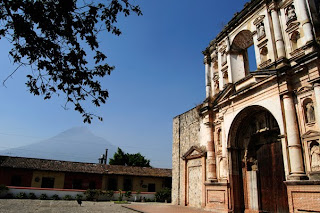





As almost every coffee farm in Guatemala, it has its own
beneficio, these facilities are often a small buildings with no much aesthetic, they are built to work not to show off. There you can find a big tank where the coffee beans will be poured, then with the help of a lot of water beans will be carried to machines that will take off their skin, then the clean beans will fall in two or three tanks where they will stay for a day or two in fermentation, after the latter process is done the beans will go to the drying patio, where they will sun dried until reach the exact final stage to be stored in
yute sacks. Many farms also raise worms into the coffee skin remainders, transforming the pulp in organic fertilizer, here you can see the soil that will be used later to fertilize coffee trees.
After our visit were done we went to a near coffee/spa to take a brunch. This is the kind of work that you don't feel like that, you feel it like fun.























































